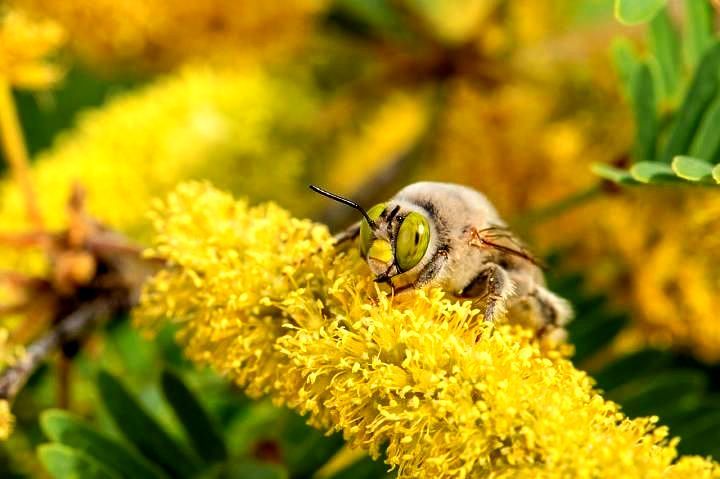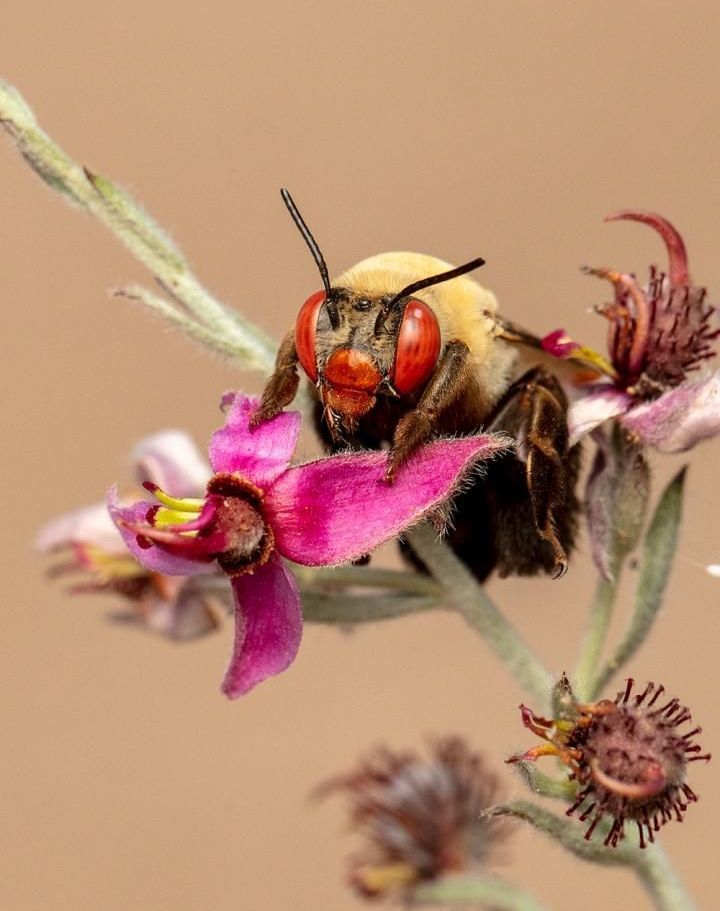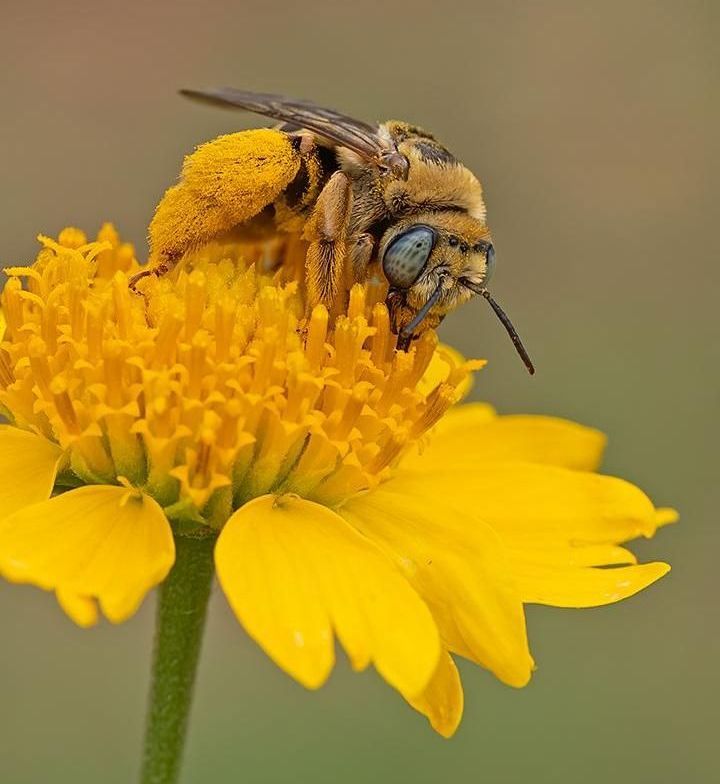World's highest concentration of bee species: The San Bernardino Valley, Arizona, sets world record

San Bernardino Valley, Arizona, United States--The United States-Mexico border traverses through large expanses of unspoiled land in North America, including a newly discovered worldwide hotspot of bee diversity; concentrated in 16 km2 of protected Chihuahuan Desert are more than 470 bee species, a remarkable 14% of the known United States bee fauna and a world record for the World's highest concentration of bee species, according to the WORLD RECORD ACADEMY.
Photo above: One of the spring-active desert bees, male Centris caesalpiniae on a flower of Acacia. Credit Bruce D. Taubert
"This globally unmatched concentration of bee species is reported by Dr. Robert Minckley of the University of Rochester and William Radke of the United States Fish and Wildlife Service in the open-access, peer-reviewed Journal of Hymenoptera Research.
"Scientists studying native U.S. bees have long recognized that the Sonoran and Chihuahuan deserts of North America, home to species with interesting life histories, have high bee biodiversity. Exactly how many species has largely remained speculation. Together with students from Mexico, Guatemala and the United States, the authors made repeated collections over multiple years, identifying more than 70,000 specimens," The EurekAlert reports.

Photo above: One of the late-summer desert bees, a long-horned female bee of the Svastra genus, on a flower of Verbesina enceliodes. Credit Bruce D. Taubert
"In the midst of the Chihuahuan Desert, straddling the border of southeastern Arizona and Sonora, Mexico, the San Bernardino Valley is an oasis of life. Following rains, especially the monsoon downpours of late summer, the area explodes with an abundance of flowers—and a bevy of bees. In fact, research by entomologist Bob Minckley shows that this area has the highest concentration of bee species in the world," the National Geographic Reports.
"In a recent paper published in the Journal of Hymenoptera Research, Minckley and San Bernardino National Wildlife Refuge manager Bill Radke found that 497 species of bees live within just over six square miles of the valley, a modest area for such a study, 10 times smaller than Washington D.C.
"Though the scientists knew the area was rich with species, they were still surprised. “The density of bees there is astronomical—far and away higher than anywhere else in the world that’s been carefully studied,” says Minckley, a professor at the University of Rochester."

Photo above: One of the spring-active desert bees, male Centris caesalpiniae on a flower of Acacia. Credit Bruce D. Taubert
"The study had neat bee facts. First, more than 90 percent of the insects the researchers found were solitary species with no hive or nestmates. Those aboveground bees lived in the spring or fall for a few weeks," the Outsider reports.
"Many bees came in different colors and sizes. For example, the tiniest American bee, Perdita minima, is about the size of the word “trust” (from “In God, We Trust”) on a U.S. quarter.
"Many bees went after one plant, the prickly pear cacti, or a group of similar plants. Chimney bees and European honeybees took to the plant.
"The United States-Mexico border traverses through large expanses of unspoiled land in North America, including a newly discovered worldwide hotspot of bee diversity. Concentrated in 16 km2 of protected Chihuahuan Desert are more than 470 bee species, a remarkable 14% of the known United States bee fauna," the EurekAlert reports.
"This globally unmatched concentration of bee species is reported by Dr. Robert Minckley of the University of Rochester and William Radke of the United States Fish and Wildlife Service in the open-access, peer-reviewed Journal of Hymenoptera Research.
"Scientists studying native U.S. bees have long recognized that the Sonoran and Chihuahuan deserts of North America, home to species with interesting life histories, have high bee biodiversity. Exactly how many species has largely remained speculation. Together with students from Mexico, Guatemala and the United States, the authors made repeated collections over multiple years, identifying more than 70,000 specimens."
"The San Bernardino Valley (Spanish: Valle de San Bernardino) is a valley in Southern California located at the south base of the Transverse Ranges. It is bordered on the north by the eastern San Gabriel Mountains and the San Bernardino Mountains; on the east by the San Jacinto Mountains; on the south by the Temescal Mountains and Santa Ana Mountains; and on the west by the Pomona Valley. Elevation varies from 590 feet (180 m) on valley floors near Chino to 1,380 feet (420 m) near San Bernardino and Redlands. The valley floor is home to over 80% of the more than 4 million people in the Inland Empire region."
"The San Bernardino Valley owes its existence to the convergence of several mountain ranges that feed into the Santa Ana River basin. This basin ultimately channels water to the Pacific Ocean via Riverside and Orange County.[6] The valley connects several open space natural areas, mountains, and valley vistas. The San Bernardino Valley is surrounded by nature preserves, national forests, and recreational areas. Many people travel through the valley for a variety of outdoor mountain sports, including skiing, hiking, biking, and ballooning—in the mountain resorts of Crestline, Lake Arrowhead and Big Bear City.
"The climate is Mediterranean with cool-to-cold, wet, and in some cases snowy winters, and dry, hot summers. Usually the areas north of Interstate 210 and east of Interstate 215 see colder weather in the winter with occasional snowfall. Sage scrub and the Yucca plant are the predominant natural vegetation along washes and uplands; it intergrades with chaparral at elevations of 600 to 700 meters. Other vegetation consists of a patchwork of grasslands, riparian woodlands, and mixed hardwood forests, which border the valley in the mountains on the north and east." (Wikipedia)
Facts about bees (from BBC)
- There are over 16,000 known bee species in seven recognised families.
- Some species, such as honeybees, bumblebees and stingless bees, live in colonies, while others are solitary insects
- Although some groups, such as bumblebees, are well studied, the vast majority, more than 96% of bee species are poorly documented
- Many crops, especially in developing countries, rely on native bee species, not honey bees.
Original source: Minckley RL, Radke WR (2021) Extreme species density of bees (Apiformes, Hymenoptera) in the warm deserts of North America. Journal of Hymenoptera Research 82: 317-345. https://doi.org/10.3897/jhr.82.60895
Journal: Journal of Hymenoptera Research
DOI: 10.3897/jhr.82.60895


